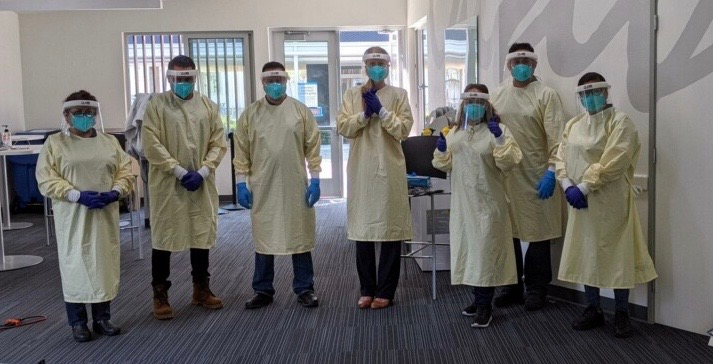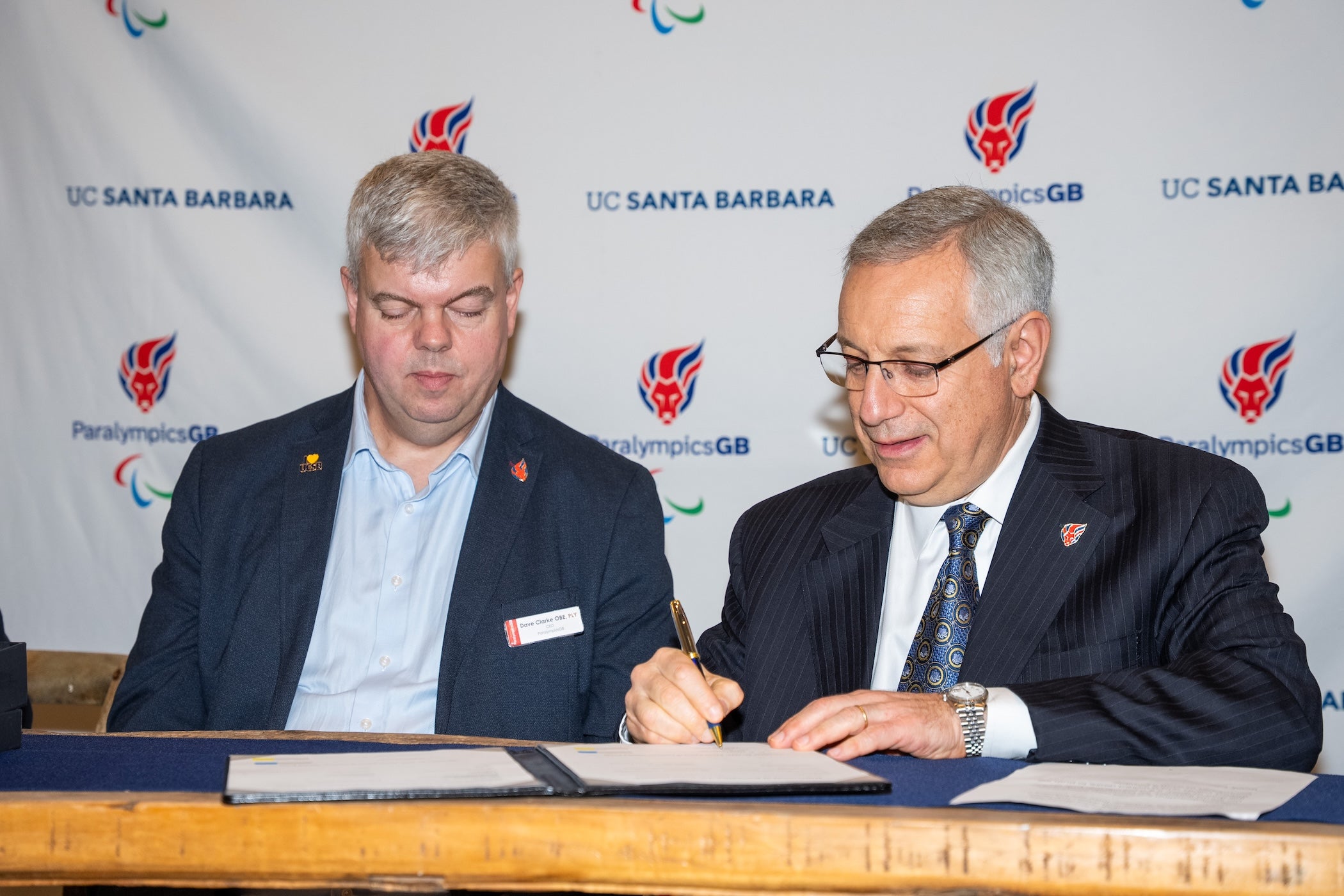
Acing their Tests
Facing down a proliferating global pandemic by mid-2020, UC Santa Barbara, as with all UC campuses, needed to be able to test thousands of staff and students for COVID-19 — and quickly. But unlike at some of those other campuses, there was no medical center at UC Santa Barbara to shoulder the load.
What to do?
Build its own testing operation from the ground up, of course, a feat the campus accomplished with remarkable speed thanks to an all-hands-on deck ethos that mobilized staff and faculty from multiple departments and units — all eager to collaborate and ready to help.
“Many dozens of people, maybe 100 different people — at least 100 — have played a role at some point in making this happen and making it successful,” said Professor Stu Feinstein, coordinator of the campus’s COVID-19 Response Team. “Everybody has been incredibly cooperative and has in fact jumped at the opportunity to help out.”
Since efforts to test on campus first launched, nearly 200,000 tests have been administered to more than 30,000 different people.
And it all started with two empty rooms in the new BioEngineering building and Professors Carolina Arias and Stu Feinstein, who took on the responsibility for getting a lab outfitted and operating with the appropriate biochemistry and molecular biology procedures. Chuck Haines and the Office of Budget & Planning team navigated myriad supply chain issues to procure new lab instrumentation, with support from the Chancellor’s office. Next, Betsy Malear and Holly Smith from Student Health, who got to work setting up facilities to collect patient samples. At the same time, Smith and Drs. Laura Polito and Elizabeth Toro assembled a team of nurses to conduct case investigations and contact tracing. Additionally, Drs. Vejas Skripkus, executive director of Student Health, and Mary Ferris, former executive director of Student Health, both made critical contributions to many facets of the effort.
Courtesy of key contributions by Lisa Foley, lab manager for Student Health, the campus lab — only four months after Professor Arias first opened those empty rooms — achieved the CLIA certification required to process its own diagnostic COVID-19 samples. That ability, combined with ongoing collaborations with locally based Aptitude Diagnostics and UCLA’s SwabSeq, vastly improved UCSB’s testing capacity and efficiency.
“People think clinical testing and they think of a lab, but a testing program is much more than what goes on in the lab,” said Feinstein. “First you have to acquire the samples from thousands of people per week, then you have to get those samples to a lab to be processed and then you have to get the results to the individuals who were tested and their clinicians, then you have to contact-trace the positive cases. It’s three legs on the stool to make a testing program work.”
And none of it would have worked, Malear said, without the many campus staff members from other departments who joined the testing operation when their regular units had essentially gone dark during the shutdown. Thanks to UCSB’s Temporary Work Opportunity Program, some three dozen employees from Housing, Dining & Auxiliary Enterprises (HDAE) alone were reassigned to assist the COVID-19 mitigation team, where they were carefully trained.
“We had volunteers from Student Health, Health and Wellness and other campus departments but we needed lots more people and HDAE helped us tremendously when we put out that call, including Willie Brown, Jill Hurd and Marlene Cohen — without all of them we wouldn’t have had testing,” Malear said. “We trained them in infection control and proper technique and I’m very proud of the fact that we haven’t had any transmissions at our testing site.”
In September 2021, Loma Pelona, the testing site, had to dramatically increase its testing capacity. Originally intending to have to test only a few hundred unvaccinated students before the start of the fall quarter, as was true at other sister UC campuses, the clinic had to scale up on only two weeks’ notice when the Delta variant surge upended testing plans across the UC.
“In the fall we went from thinking about 500 tests over a week to 10,000 for move-in week,” said Feinstein. “In the lab we had to have enough supplies and people to perform 10,000 tests — that’s a 20X increase. We had to hustle. Now this winter quarter of 2022, the same thing has happened because of the omicron variant. Hundreds of tests, Betsy’s people can do that in their sleep, but 10,000 tests over a week or two is a huge lift. And we pulled it off in Fall 2021 and we’re in the midst of it again in Winter 2022.”
Not only did everyone get tested — they got their results quickly, and still are. Speed is a critical piece of the puzzle, according to Feinstein.
“With COVID, time is everything,” said Feinstein. “One thing I’m so proud of with our lab, they get samples back to those who were tested and to the clinical team, sometimes the same day — and almost always within 24 hours. In contrast, when COVID started back in 2020, labs were taking 7-10 days to get tests back. That’s useless. If it takes that long for a result and someone is positive, they’re out and about sharing their virus all that time.”
The campus testing effort is a multifaceted endeavor made all the more impressive because it doesn’t have a medical center or a school of public health.
It was Malear who spearheaded the effort to provide self-administered test kits to the campus community in addition to in-person appointments. Realizing pretty quickly that the vending machine approach employed at some other universities would be unwieldy and inefficient for UC Santa Barbara, “we opted for human vending machines,” Feinstein said. “And that was Betsy’s brainchild.”
Today the kits are widely available across campus for drop-off at Loma Pelona, by appointment, and subsequent analysis.
The campus also is currently providing, on departmental request, rapid antigen tests for those situations where quick results are crucial: a job applicant on campus for the day, for example. It’s another tool in the mitigation kit, noted Feinstein, while emphasizing that antigen tests are not a substitute for the gold-standard PCR based tests.
“They are not interchangeable. They are complementary,” he explained. “The PCR test is excruciatingly sensitive — it can pick up just three molecules. But it does require a lab and it generally takes around 24 hours to get a result. A rapid antigen test gives results in minutes but it doesn’t have the same sensitivity. Both tests have important roles, but PCR based tests remain the backbone of our testing and mitigation efforts.”
With the campus set to resume in-person instruction Jan. 31 following a four-week remote period to mitigate the logistical issues of omicron — testing, vaccinations, isolation — Feinstein and Malear say the testing operation is ready for whatever comes next.
“If we get slammed with another bad variant, we’ll pivot again,” said Feinstein. “But right now omicron is descending. Nothing stays the same for long with COVID, so we’ll see what happens. But Betsy has really improved the way we get samples, with much more simplicity and efficiency than we had before. We’re doing everything we need to do with our testing site. It works for us.”
“It’s all been one big collaboration,” Malear added, “and we expect to continue to do so.”



